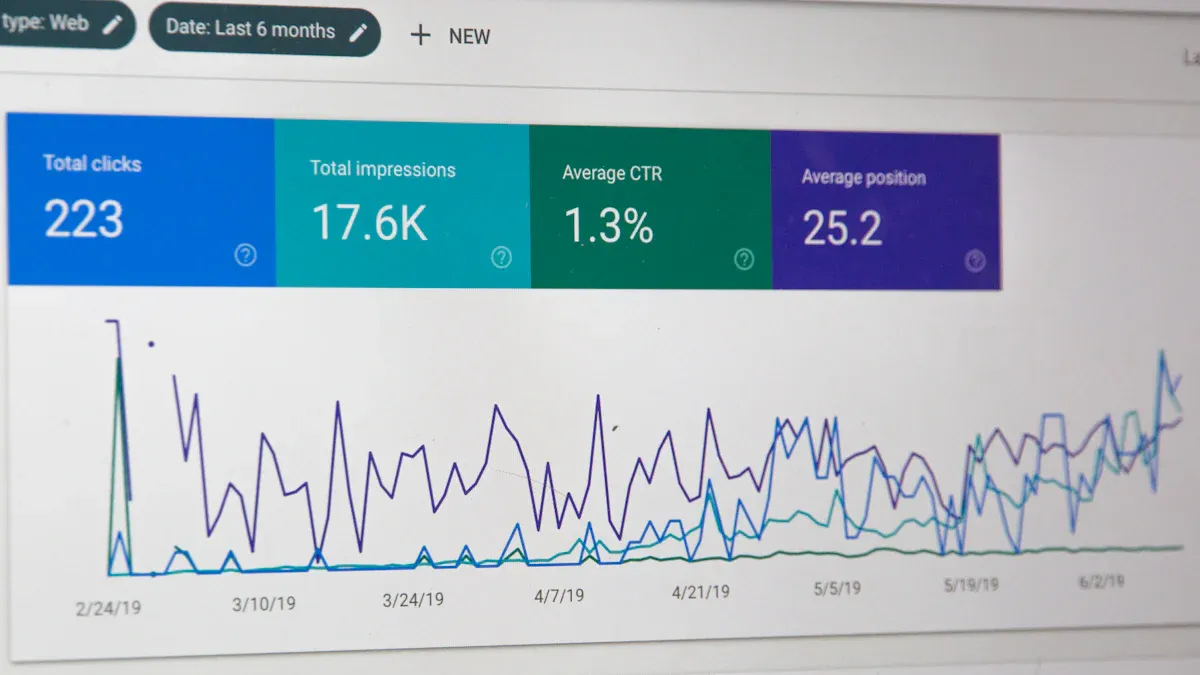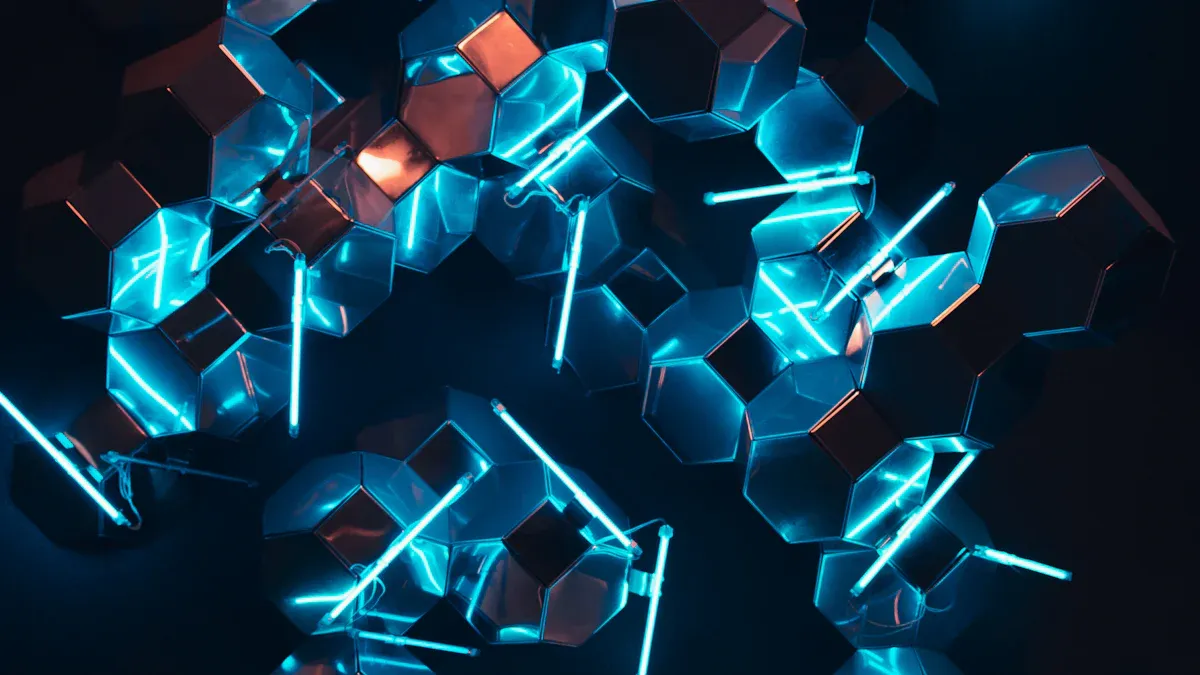
Imagine a world where search engines understand your intent, not just your words. Knowledge graphs make this possible by connecting data in meaningful ways. They empower you to optimize SEO strategies and streamline data management. With AI driving their evolution, these systems deliver smarter solutions and unlock new opportunities for growth.
Key Takeaways
-
Knowledge graphs link different data sources, giving a clear view to help decisions and new ideas.
-
Using structured data makes websites easier to find, bringing more visitors and clicks.
-
AI-powered knowledge graphs handle data updates and connections, keeping data correct and following rules.
What Are Knowledge Graphs?
Definition and Core Components
A knowledge graph is an organized representation of real-world entities and their relationships. It connects data from various sources into a unified, structured, and interconnected format. This structure enables you to access a comprehensive view of information, making it easier to derive insights.
Knowledge graphs consist of several core components:
-
Interlinked Descriptions of Entities: Each entity, such as a person, place, or object, is represented as a node. Semantic links, or edges, connect these nodes, showing how entities relate to one another.
-
Formal Semantics and Ontologies: Predefined rules and structures guide how information is represented and interpreted.
-
Data Integration: Knowledge graphs combine structured, semi-structured, and unstructured data into a cohesive framework.
-
Scalability and Flexibility: They handle growth in data, relationships, and queries efficiently.
These components work together to create a system that supports knowledge graph reasoning, allowing you to uncover patterns and relationships within data.
How Knowledge Graphs Work
Knowledge graphs operate by extracting, organizing, and connecting data. AI plays a crucial role in this process, enhancing the efficiency and accuracy of knowledge graph construction. For instance, large language models (LLMs) like GPT-4 assist in entity and relationship extraction, which are essential for building knowledge graphs.
The process involves several steps:
-
Knowledge Extraction: AI tools extract information from diverse sources, identifying entities and their relationships.
-
Entity Alignment: Subgraphs referring to the same real-world entities are aligned to ensure consistency.
-
Knowledge Graph Reasoning: AI algorithms analyze the graph to infer new relationships and insights.
Empirical studies highlight the adaptability of AI in knowledge graph technology. For example, instruction-tuned LLMs improve performance in data-scarce scenarios, making them valuable for constructing and maintaining knowledge graphs. These advancements enable you to leverage knowledge graph reasoning for better decision-making and innovation.
Knowledge Graphs in SEO

Enhancing Semantic Search
Knowledge graphs revolutionize semantic search by enabling search engines to understand the meaning behind your queries. Instead of matching keywords, they connect related concepts to deliver richer and more accurate results. For instance, when you search for “Leonardo da Vinci,” the system links this term to related topics like “Renaissance” or “Mona Lisa.” This approach enhances your search experience by providing contextually relevant information.
AI plays a pivotal role in this process. Advanced models like RGCN and CompGCN improve the reasoning capabilities of knowledge graphs, ensuring that search engines can interpret complex relationships between entities. These models allow systems like Google to deliver precise answers, reducing the number of queries you need to find what you're looking for. Businesses that adopt semantic search powered by knowledge graphs often see tangible benefits. Rakuten, for example, reported a 5% increase in sales after implementing this technology.
|
Model |
Description |
|---|---|
|
KGE Models |
CNNs outperform traditional neural networks in knowledge graph embedding tasks. |
|
RGCN |
Enhances GCN by incorporating relation type embeddings, improving KG reasoning. |
|
CompGCN |
Achieves accurate representation learning for multi-relational graphs. |
Improving Website Visibility
Knowledge graphs significantly boost your website's visibility by improving how search engines interpret and display your content. When you use structured data to organize your site, search engines like Google can create rich snippets or knowledge panels that appear directly on the search results page. These features increase your site's credibility and make it more likely for users to engage with your content.
Statistical data underscores this impact. A study by Search Engine Journal revealed that businesses leveraging knowledge graphs experienced up to a 30% increase in organic website traffic. Similarly, Search Engine Watch reported that optimizing for knowledge graphs can boost click-through rates (CTR) by as much as 40%. These metrics highlight the importance of integrating structured data into your SEO strategy.
|
Evidence Description |
Impact on Website Visibility |
|---|---|
|
Knowledge panels enhance user trust and credibility |
Increased likelihood of user engagement with the information presented |
|
Knowledge Graph improves SEO through accurate information on SERP |
Boosts online visibility and click-through rates (CTR) |
|
Rise of zero-click searches due to Knowledge Graph |
Highlights the need for optimization to ensure accurate representation of information |
Boosting User Engagement
Knowledge graphs enhance user engagement by delivering personalized and interactive search experiences. By connecting structured data with user intent, they allow search engines to present information in a way that resonates with your audience. For example, when users search for a product, a well-optimized knowledge graph can display detailed specifications, reviews, and related products directly on the search results page.
AI-driven analysis further refines this process. Machine learning algorithms analyze user behavior to predict preferences and tailor search results accordingly. This personalization keeps users on your site longer and encourages them to explore more content. Businesses that prioritize user engagement through knowledge graphs often see measurable results. Optimized knowledge panels and rich snippets not only improve CTR but also foster trust and loyalty among users.
Tip: To maximize user engagement, ensure your structured data is accurate and up-to-date. This helps search engines display the most relevant information to your audience.
Knowledge Graphs in Enterprise Data Governance
Data Integration and Connectivity
Knowledge graphs redefine how you approach data integration by connecting diverse datasets into a unified framework. Instead of relying on isolated data silos, they create a network of interconnected information, enabling seamless data accessibility and analysis. This interconnected structure enhances your ability to process and analyze data efficiently, especially in complex environments.
For example, JPMorgan Chase uses knowledge graphs to manage its vast data landscape, which spans over 1,000 applications and 83 million database columns across 2 million tables. By integrating this data, the organization ensures regulatory compliance and improves accessibility for auditing and analysis. Similarly, AstraZeneca employs disease-specific knowledge graphs to uncover critical interactions in drug discovery, enhancing research outcomes.
Note: AI-driven tools play a crucial role in this process. They automate the integration of structured and unstructured data, providing real-time insights that support decision-making. Gartner's 2024 Hype Cycle highlights how knowledge graph technology is increasingly recognized for its ability to integrate and analyze complex data, driving innovation in enterprise data governance.
Ensuring Data Traceability
Traceability is essential for maintaining data privacy and security in enterprise data governance. Knowledge graphs excel in this area by offering a transparent view of data origins and transformations. They allow you to trace information back to its source, ensuring accountability and compliance auditing.
A quality traceability system implemented with Neo4j and MySQL demonstrates this capability. It enables enterprises to track suppliers and production details when quality issues arise, reducing investigation workloads and improving efficiency. In agricultural products, this system ensures that data processing and analysis remain accurate and reliable.
Tip: To maximize traceability, integrate AI algorithms into your knowledge graph framework. These algorithms enhance data analysis by identifying anomalies and automating compliance checks, ensuring your organization adheres to data privacy and security standards.
|
Aspect |
Description |
|---|---|
|
System Design |
Quality traceability system with B/S architecture, implemented in Java using MySQL and Neo4j. |
|
Functionality |
Enables tracing back to suppliers and production details when quality issues arise. |
|
Efficiency |
Reduces investigation workload and improves overall traceability efficiency in agricultural products. |
Supporting Decision-Making
Knowledge graphs empower data-driven decision-making by revealing hidden relationships and dependencies within your data. They create a “single source of truth,” enabling you to make strategic and operational decisions with confidence. By linking concepts without altering the underlying data, knowledge graphs provide a flexible data layer that supports AI-driven insights.
For instance, multi-agent reinforcement learning enhanced by knowledge graphs improves adaptive scheduling in smart manufacturing. This approach outperforms traditional methods by incorporating real-world machining experiences into decision-making processes. Additionally, advanced analytics applied to knowledge graphs can forecast project delays and compliance breaches, helping you mitigate risks proactively.
Callout: Knowledge graphs are not just tools for data analysis; they are catalysts for innovation. By connecting data silos and automating risk identification, they enable you to make informed decisions that drive business outcomes.
|
Evidence Description |
Key Findings |
|---|---|
|
Knowledge graph-enhanced multi-agent reinforcement learning for adaptive scheduling in smart manufacturing |
Machine Graph improves decision-making capabilities in dynamic scheduling, outperforming traditional methods by incorporating real-world machining experiences. |
Unordered List of Benefits:
-
Knowledge graphs integrate diverse data types, providing a comprehensive view for auditing.
-
They automate risk identification using machine learning, enhancing decision-making through real-time monitoring.
-
They reveal complex relationships between entities, improving strategic planning and operational efficiency.
Challenges in Knowledge Graph Implementation
Addressing Data Quality
Maintaining high data quality is crucial for effective knowledge graph systems. You often face challenges like inconsistencies, sparse data structures, and semantic gaps when integrating information from multiple sources. Specialized algorithms and machine learning techniques help you manage these issues. For example, advanced graph algorithms capture semantic richness while reducing computational complexity. Data cleaning tools also play a vital role in optimizing and refining your knowledge graph.
AI-powered analytics tools enhance data quality management by identifying gaps and areas needing improvement. These tools track user interactions to inform optimization efforts and refine search capabilities. By automating complex tasks, AI ensures your knowledge graph remains accurate and reliable. This approach strengthens enterprise data governance, enabling you to make informed decisions based on trustworthy data.
Managing Scalability
Scalability presents a significant challenge as knowledge graphs grow in size and complexity. Dense graphs with thousands or millions of nodes often become difficult to interpret. Node-link diagrams, commonly used for visualization, can turn into “hairballs” that obscure meaningful information. Computational difficulties in rendering large graphs further complicate scalability.
AI-driven solutions address these challenges by optimizing graph visualization and processing. Machine learning algorithms simplify dense graphs, making them easier to analyze. These tools also enhance performance by automating scalability checks and reducing computational overhead. By leveraging AI, you can ensure your knowledge graph adapts to growing data demands without sacrificing usability.
Maintenance and Updates
Keeping your knowledge graph up-to-date requires continuous maintenance. Data evolves rapidly, and outdated information can compromise the graph's accuracy. AI tools streamline this process by automating updates and integrating new data sources. They also monitor user engagement to identify areas needing enhancement, ensuring your graph remains relevant.
Regular optimization efforts improve the graph's performance and usability. Analytics tools refine search capabilities and provide deeper insights into data relationships. By prioritizing maintenance, you can maximize the value of your knowledge graph and support long-term data quality management.
Future Trends for Knowledge Graphs in 2025

AI-Driven Knowledge Graph Construction
Artificial intelligence is revolutionizing how you build knowledge graphs. Automated systems now extract, organize, and connect data with remarkable precision. AI models like GPT-4.0 enhance the representation of data relationships, transforming hidden associations into explicit semantic networks. For example, in the automotive sector, knowledge graphs assist in engine fault diagnosis and intelligent prediction. Research by Tang et al. (2023) and Xu et al. (2022) highlights how AI-driven knowledge graph technology improves anomaly detection and retrieval accuracy in diesel engines.
These advancements reduce manual effort and improve scalability. AI algorithms analyze vast datasets, identify patterns, and construct graphs faster than traditional methods. This efficiency allows businesses to focus on deriving insights rather than grappling with data integration challenges. By leveraging AI, you can create dynamic knowledge graphs that adapt to evolving data landscapes.
Cross-Domain Applications
Knowledge graphs are breaking barriers across industries. In healthcare, a sepsis-specific knowledge graph developed using GPT-4.0 enhances clinical decision-making. It extracts critical insights, helping doctors provide better care. Similarly, insurance companies use knowledge graph technology to personalize products and respond to market changes. This approach improves operational efficiency and customer satisfaction.
Search engines also benefit from cross-domain applications. Google’s use of knowledge graphs enhances search accuracy by understanding context and relationships. These examples demonstrate how knowledge graphs adapt to diverse fields, offering tailored solutions and measurable impacts.
Integration with Emerging Technologies
The integration of knowledge graph technology with emerging technologies is shaping the future. Graph-based systems are evolving to support real-time applications like augmented reality (AR) and virtual reality (VR). These integrations create immersive experiences by connecting contextual data with user interactions. For instance, AR applications can use knowledge graphs to overlay relevant information onto physical environments, enriching user experiences.
Advances in graph database technologies further enhance scalability and performance. As enterprises adopt these systems, they unlock new possibilities for enterprise data governance and innovation. The market for knowledge graph technology is projected to grow significantly, with an expected size of $2,522 million by 2025, reflecting a compound annual growth rate (CAGR) of 34%.
Tip: To stay ahead, explore how knowledge graphs can complement your existing technologies. This approach ensures you remain competitive in a rapidly evolving digital landscape.
Knowledge graphs redefine how you approach SEO and data management. They integrate diverse datasets, enhance discovery, and automate governance. AI amplifies their capabilities, enabling real-time decision-making and improving transparency. By adopting knowledge graphs, you unlock opportunities for innovation, ensuring your business thrives in a competitive, data-driven landscape.
Note: Knowledge graphs improve machine learning accuracy by up to 300%, ensuring consistent and high-quality data integration.
|
Description |
|
|---|---|
|
Enhanced Data Integration |
Knowledge graphs offer a way to integrate data from various sources. |
|
Improved Data Discovery |
Knowledge graphs greatly improve the ability of users to discover data. |
|
Automated Governance |
By integrating AI, organizations better manage complex data landscapes. |
|
Regulatory Compliance |
Regulations are better managed through compliance systems. |
|
Data Traceability |
Users can trace all data lineage through the systems. |
FAQ
What role does AI play in building knowledge graphs?
AI automates data extraction, entity recognition, and relationship mapping. It improves accuracy and scalability, making knowledge graph construction faster and more efficient.
How do knowledge graphs improve search engine results?
Knowledge graphs use AI to understand relationships between entities. This enables search engines to deliver contextually relevant and precise results, enhancing your search experience.
Can AI help maintain knowledge graphs over time?
Yes! AI monitors data changes, automates updates, and identifies inconsistencies. This ensures your knowledge graph stays accurate and adapts to evolving data landscapes.
Tip: Leverage AI tools to simplify knowledge graph management and maximize their potential for your business.
